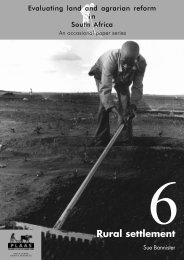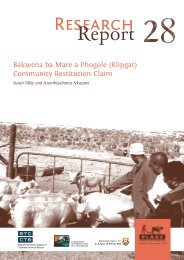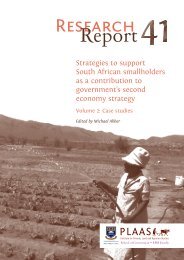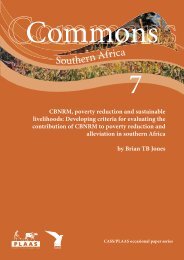A critical appraisal of South Africa's market-based land reform policy
A critical appraisal of South Africa's market-based land reform policy
A critical appraisal of South Africa's market-based land reform policy
You also want an ePaper? Increase the reach of your titles
YUMPU automatically turns print PDFs into web optimized ePapers that Google loves.
A <strong>critical</strong> <strong>appraisal</strong> <strong>of</strong> <strong>South</strong> Africa’s<br />
<strong>market</strong>-<strong>based</strong> <strong>land</strong> <strong>reform</strong> <strong>policy</strong><br />
Chapter 5: The LRAD programme<br />
This chapter provides an overview <strong>of</strong> the LRAD <strong>policy</strong> and its<br />
implementation in Limpopo, <strong>based</strong> on <strong>of</strong>ficial <strong>policy</strong> documents and<br />
reports and elaborated by implementation <strong>of</strong>ficials. It explains the aims<br />
and objectives <strong>of</strong> the programme, the services provided to beneficiaries<br />
through LRAD and the implementation structures and procedures in<br />
Limpopo. It also analyses some <strong>of</strong> the data available on progress to date,<br />
and outlines perceptions <strong>of</strong> progress and challenge held by the<br />
government <strong>of</strong>ficials responsible for LRAD implementation.<br />
Aims and objectives<br />
According to DLA <strong>policy</strong><br />
documents the objectives <strong>of</strong><br />
LRAD, which are to be achieved<br />
in the 15 years from 2000, are to:<br />
! increase access to agricultural<br />
<strong>land</strong> by black people (Africans,<br />
Coloureds and Indians) and to<br />
contribute to the redistribution <strong>of</strong><br />
approximately 30% <strong>of</strong> the<br />
country’s commercial agricultural<br />
<strong>land</strong> (i.e. formerly ‘white<br />
commercial farm<strong>land</strong>’) over the<br />
duration <strong>of</strong> the programme<br />
! contribute to relieving the<br />
congestion in over-crowded<br />
former home<strong>land</strong> areas<br />
! improve nutrition and incomes <strong>of</strong><br />
the rural poor who want to farm<br />
on any scale<br />
! overcome the legacy <strong>of</strong> past<br />
racial and gender discrimination<br />
in ownership <strong>of</strong> farm<strong>land</strong><br />
! facilitate structural change over<br />
the long term by assisting black<br />
people who want to establish<br />
small and medium-sized farms<br />
! stimulate growth from agriculture<br />
! create stronger linkages between<br />
farm and <strong>of</strong>f-farm income<br />
generating activities<br />
! expand opportunities for<br />
promising young people who stay<br />
in rural areas<br />
! empower beneficiaries to improve<br />
their economic and social wellbeing<br />
! enable those presently accessing<br />
agricultural <strong>land</strong> in communal<br />
areas to make better productive<br />
use <strong>of</strong> their <strong>land</strong><br />
! promote environmental<br />
sustainability <strong>of</strong> <strong>land</strong> and other<br />
natural resources<br />
(DLA 2001:6).<br />
Most <strong>of</strong> these objectives are vague and<br />
have no quantitative or qualitative<br />
component that could be effectively<br />
monitored. The target <strong>of</strong> redistributing<br />
‘approximately 30%’ <strong>of</strong> commercial<br />
agricultural <strong>land</strong> may sound reasonably<br />
clear on first reading, but it is not explained<br />
anywhere how much <strong>of</strong> this 30%<br />
LRAD is expected to ‘contribute’. In<br />
addition, exactly which <strong>land</strong> is not clear as<br />
the previous section <strong>of</strong> the LRAD <strong>policy</strong><br />
document refers to 30% <strong>of</strong> ‘all agricultural<br />
<strong>land</strong>’ while the objectives section refers to<br />
30% <strong>of</strong> formerly ‘white commercial<br />
farm<strong>land</strong>’. There is a distinct difference<br />
between these two types <strong>of</strong> <strong>land</strong>. This lack<br />
<strong>of</strong> clarity on the targeted amount <strong>of</strong> <strong>land</strong><br />
combined with the long list <strong>of</strong> various<br />
types <strong>of</strong> objectives does not help give a<br />
clear focus and purpose to the programme.<br />
The nature <strong>of</strong> the objectives also makes it<br />
18
















